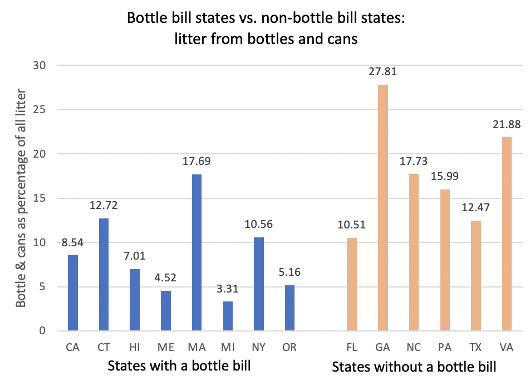REDUCING PLASTIC POLLUTION
Elly Boehmer // Environment Virginia // eboehmer@environmentvirginia.org
Jim Deppe // Lynnhaven River NOW // jim@lrnow.org
Emily Foppe // Clean Fairfax // emily@cleanfairfax.org
Katie Register // Clean Virginia Waterways of Longwood University // registerkm@longwood.edu
Clean Water & Flood Resilience
Executive Summary
Eradicating plastic pollution is a top priority for many Virginians. Building on this concern, now is the time to craft policies and laws that will keep plastic waste out of Virginia’s streams, rivers, and coastal waters. Waters polluted with plastic have negative health effects on humans and wildlife. We can further tackle plastic pollution in Virginia by eliminating the most harmful types of mismanaged waste, incentivizing sustainable disposal of what we do use, increasing producer responsibility, and encouraging the shift to sustainable and reusable products. Virginia has made progress to eliminate plastic pollution in previous years and further actions would continue this legacy.
Challenge
Our society produces single-use plastic items that are discarded, creating pollution and further extraction of natural resources.1 When mismanaged, trash ends up in Virginia’s natural landscapes and waterways. The unintended consequences of single-use plastics result in devastating impacts on wildlife, including sea turtles, birds, fish, mammals, and important water-filtering bivalves like oysters and mussels through entanglement and ingestion.2
Eighty percent of debris in the oceans comes from land: mismanaged waste, litter, illegal dumping, and uncovered trucks (e.g., food- and beverage-related items, cigarette butts and plastic grocery bags).3,4
This mismanaged waste disproportionately affects historically disadvantaged communities as it disparately burdens BIPOC and communities of low wealth.5 Exposure to plastic additives have negative biological effects on humans and wildlife.6
Abandoned and derelict vessels (ADVs) obstruct navigational channels, cause harm to the environment, and diminish commercial and recreational activities. ADVs, most of which are plastic material reinforced with glass fibers, also have negative financial impacts.
Our broken recycling system is insufficient in action, funding, and impact as it does not reduce single-use products nor does it hold producers responsible for the plastic pollution crises.
Solution
PRODUCER RESPONSIBILITY

Sharing responsibility between taxpayers/consumers and producers has these components. Photo by Clean Fairfax
Responsibility for litter clean ups, recycling, and waste disposal should be shifted from taxpayers onto manufacturers. A producer responsibility program incentivizes manufacturers to decrease packaging, increase recycled content, and create recyclable, reusable, or biodegradable products.
More and more states have established product stewardship programs where manufacturers pay for recycling and waste reduction, rather than taxpayers.
BEVERAGE CONTAINER DEPOSIT

Refundable deposits on beverage bottles and cans lead to less litter from these items as shown in this chart that compares states with and without bottle bills. Graph by Clean Virginia Waterways.
In Virginia, bottles and cans account for nearly 22% of all litter; states with container deposits have significantly less.7 Beverage container deposits (“bottle bills”) incentivize consumers to return containers for recycling. These proven programs increase recycling, while reducing litter, energy use, and greenhouse gas emissions.8
CONTINUED EFFORTS
In 2020 and 2021, Virginia made progress by passing a ban on single-use foam containers, banning intentional balloon releases, and increasing the litter tax. Additionally, eight localities used their new authority to put a fee on plastic bags. Challenges include: the 2022 General Assembly delayed the ban on foam plastic by five years. Virginia’s litter tax is still inadequate, generating 40-80% less revenue than other states.9
Policy Recommendations
Ban the use of single-use expanded polystyrene by food vendors by 2024 rather than having a 7-year phase-out period.
Establish a producer responsibility program focused on a reduction in harmful packaging, where manufacturers pay for recycling and waste reduction, rather than taxpayers.
Establish a statewide beverage container deposit (“bottle bill”).
Increase the Virginia Litter Tax to be based on volume of sales rather than a flat tax of $20 per business, and index the rate to inflation so it adjusts periodically. Also, allow non-profit organizations access to the Litter Control & Recycling Fund.
Fund the Virginia Abandoned and Derelict Vessel Prevention and Removal Program at $3 million for FY 2023-24.
End Notes
1 “Advancing Sustainable Materials Management: 2016 and 2017 Tables and Figures, Tables 1-4,” U.S. EPA (November 2019). https://www.epa.gov/sites/default/files/2019-11/documents/2016_and_2017_facts_and_figures_data_tables_0.pdf.
2 Ken Christensen. “Guess What’s Showing Up in Our Shellfish? One Word: Plastics.” National Public Radio (September 19, 2017). https://www.npr.org/sections/thesalt/2017/09/19/551261222/guess-whats-showing-up-in-our-shellfish- one-word-plastics.
3 “2021-2025 Virginia Marine Debris Reduction Plan,” Virginia Coastal Zone Management Program (2021). https://www.deq.virginia.gov/coasts/marine-debris.
4 “Data from the 2019 International Coastal Cleanup in Virginia,” Clean Virginia Waterways of Longwood University, http://www.longwood.edu/cleanva/Data,ICCinVA.html.
5 “Neglected: Environmental Justice Impacts of Marine Litter and Plastic Pollution,” United Nations Environment Programme (April, 2021). https://wedocs.unep.org/bitstream/handle/20.500.11822/35417/EJIPP.pdf.
6 Hale, Robert C., Meredith E. Seeley, Mark J. La Guardia, Lei Mai, and Eddy Y. Zeng. “A global perspective on microplastics.” Journal of Geophysical Research: Oceans 125, no. 1 (2020): e2018JC014719.
7 “Marine Litter Report: Littered Bottles & Cans: Higher in Virginia Than in States with Bottle Bills,” Clean Virginia Waterways (2020). http://www.longwood.edu/cleanva/publications.html.
8 Schuyler, Q., B. Hardesty, T. Lawson, K. Opie & C Wilcox. “Economic incentives reduce plastic inputs to the ocean.” Marine Policy, 96, 250-255. (2018). https://www.sciencedirect.com/science/article/abs/pii/S0308597X17305377.
9 Based on 2020 data from Tennessee, Nebraska, and Washington Departments of Revenue.
